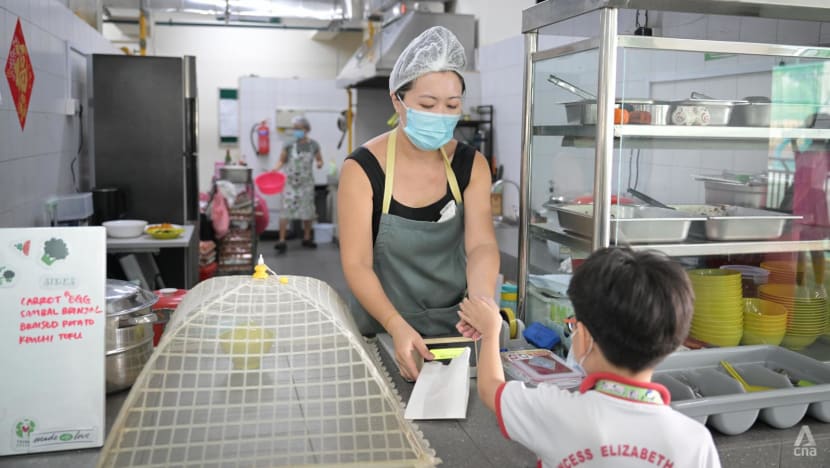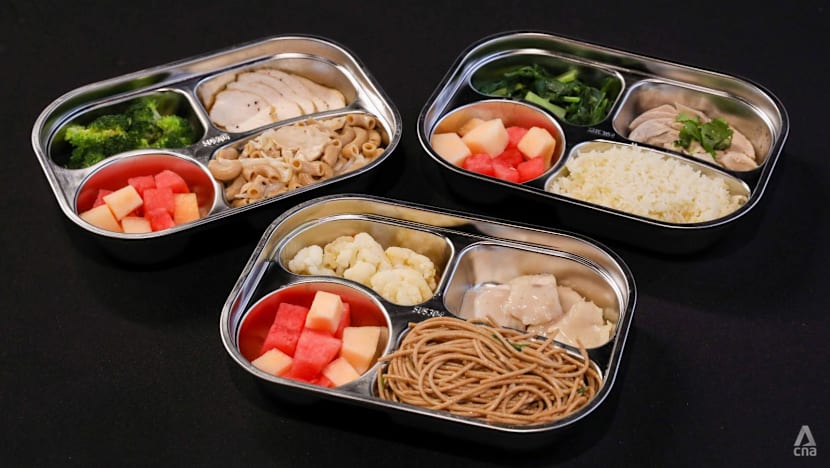Do centralised kitchens spell the end of Singapore’s school canteen culture?
Singapore’s school canteens are where many pupils first learn independence. On CNA’s Deep Dive podcast, a stallholder and caterer discuss whether the move to central kitchens could dilute that experience.


This audio is generated by an AI tool.
SINGAPORE: When school canteen vendor Rayner Tan opened his vegetarian stall at Mee Toh School in Punggol two months ago, it was not just about selling food.
“I wanted to interact more with kids. That's one of the reasons why I chose a primary school,” said Mr Tan, who had little prior experience in the food-and-beverage industry before taking up the only available non-halal vacancy at the school.
Mr Tan is among a shrinking breed of vendors who have long been part of Singaporeans’ early school years. He was sharing his views on the future of school canteens with CNA’s Deep Dive podcast.
Starting next year, 13 primary and secondary schools will switch from traditional canteens to a central kitchen model, where meals are prepared off-site. Students will be able to collect their pre-ordered food by simply tapping their bus passes at dispensers.
The move aims to tackle a growing shortage of stallholders like Mr Tan, but concerns have also been raised about what students stand to lose in the process.
VANISHING TRADE
School canteen stall rentals are low – between S$5 (US$3.90) and S$15 a month – but margins are tight.
Meals must stay affordable at around S$2 to S$2.50 a portion and comply with Health Promotion Board (HPB) nutrition guidelines, which means pricier ingredients such as whole grains and healthier-choice products, Mr Tan pointed out.
“It’s not difficult to make a profit. But the question is, how much of a profit, and whether that profit is sustainable,” he said, adding that his stall’s profit has hovered around S$2,000 per month.
Unlike larger caterers, small stallholders do not have the buying power to negotiate bulk discounts.
“Each person can only apply for one store, so we don’t get the economies of scale. It is hard to find suppliers as well when your quantity is limited, ” he said.
Add to that the manpower crunch, as stall operators can only hire Singaporeans or Permanent Residents who work for limited hours during the school day. Stalls are closed during the school holidays.
This is why most stallholders are retirees, Mr Tan noted. “If you have grandkids, then that’s perfect because (during the holidays) your grandkids are out of school as well, and you are at home to take care of them. But for the working adult, you have to find other sources of income.”
ENTER THE CENTRAL KITCHEN
Like current canteen stalls, central kitchen operators must comply with HPB guidelines. Meals must include wholegrains, 50g of vegetables and 50g of protein. Deep frying is not allowed.
The three caterers appointed to serve the 13 schools - Chang Cheng Holdings, Gourmetz and Wilmar - declined to appear on the podcast.
But this concept is not new for companies like Victus Catering, which serves international schools. It operates licensed kitchens that prepare meals in bulk before delivering them hot each morning.
Parents can pre-order meals for their children up to two months in advance, but the prices are higher than at public schools, at around S$6 to S$9 per meal.
Chang Cheng Holdings, Gourmetz and Wilmar are required to provide at least one full meal priced at no more than S$2.70 in primary schools and S$3.60 in secondary schools.

Mr Ben Airey, chief of staff and marketing manager at Victus, said economies of scale help caterers keep prices stable.
Mr Airey, who was on the same podcast, added that Victus has kept its prices “static” for nearly six years.
He said that the company ensures its food is served within two hours after cooking, offering schools consistency and safety.
The schools also discard unconsumed food after an hour, he noted, a practice he hopes will be emulated by other institutions.
“CULTURAL LOSS”
The central kitchen initiative builds on a 2022 pilot at Yusof Ishak Secondary School, managed by caterer SATS. The school’s principal Chen Ziyang previously told CNA that the model has “significantly reduced” wait times compared to traditional canteen queues.
But for stallholder Mr Tan, something deeper is at stake, especially if more schools jump on the bandwagon.
“If they're able to do it with variety and with choices. And if the kids love the food … my fear would be that more schools would just choose this easy option, and then there goes the school canteen,” said Mr Tan.
School canteens are a “uniquely Singaporean culture”, he added, where students get to learn life skills.
It is probably their first experience interacting with strangers - the “uncles” and “aunties” running the stalls - and where they learn how to handle money, said Mr Tan.
“I would think that that takes away quite a lot of autonomy from the child.”
The shift towards central kitchens also reflects broader trends in Singapore’s food scene, noted Mr Tan and Mr Airey.
Manpower shortages and rising costs have already transformed hawker centres, with shared washing facilities and digital payment systems now the norm.
Mr Tan suggested the school canteen system could be improved, for instance by introducing centralised dishwashing to ease the burden on older stallholders, or allowing moderate price adjustments to make operations more sustainable.
While this shift presents an opportunity for catering companies, for some retiree stallholders, “it’s probably the end of the line”, said Mr Airey.

















